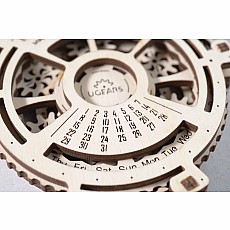Learn how the PENDULUM works: The Pendulum is a stylised educational model, an interactive study guide to the mechanism, only for learning its essentials and principles of working. The pendulum is one of the basic and most reliable time measuring mechanisms. Its working principle is based on the model's constant amplitude oscillation under the force of gravity (weight) and potential energy (tension force) of the rubber band. The rubber band powers the mechanism of the model and compensates for the pendulum's oscillations' kinetic energy loss. The device is animated by means of gear unit with a windup wheel. The model has an anchor escapement controlling the frequency of oscillations, a weight, a scape-wheel, gearing, rubber band, ratchet and pawl reducing operation error. The model has several means to control the frequency of oscillations: the weight of the pendulum bob, the vertical position of the weight on the pendulum, and the tension of the rubber band. When and who invented it: The first study of the pendulum was implemented by Galileo Galilei, an Italian engineer in the end of the 16th century. He described the property of the pendulum to preserve the consistency of the oscillations. The first person to use a pendulum in a mechanical clock and ensure a steady rate was a Dutch physicist Christiaan Huygens back in the 17th century. Usage: Pendulums are mainly used in mechanical clocks as an element of a launch mechanism and the way to provide a steady rate. In the musical sphere, metronomes that have pendulums as their chief constructional element, help musicians practice playing to a regular tempo. Pendulums are also used in geological surveying, seismography, sports, and laboratory research in mechanics and physics. o' Assemble it and discover the principle of working of the Pendulum. o' Experiment: the model comes with a Pocket Modelas Study Guide with a creation story and mechanism design as well as engaging and interesting tasks. o' Immerse yourself in Augmented Reality (AR), find out how the pendulum is used in a clock mechanism, and interact with it via the dedicated Ugears application. The mechanism of the Pendulum is composed of:
- Escapement wheel
- Needle indicator
- The pendulum with the anchor
- Pendulum bob
Self-assembly from the parts, pulled out from wooden boards, according to easy-to-follow manual instruction. No glue or cutting needed Model Size: 4.5 x 3.3 x 6.6 in Package size: 8.1 x 7.4 x 2.5 in Number of parts:' 92 Level: Easy Assembly Time: 2 hours Recommended Age: 8+
- Brand: Ugears.
- Item Number: 210000169548.
- Manufacturer Number: UTG0063.
- UPC: 4820184121041.
- Recommended for ages : 8 to 12.
- Weighs approximately: 5.00 pounds.
| Local Pickup at Pick Up at Menlo Park Store after 24 HOURS: Ready after 24 HOURS for most orders in stock at this location | $0.00 | |
| Local Pickup at Pick Up at Los Altos Store after 24 HOURS: Ready after 24 HOURS for most orders in stock at this location | $0.00 | |
| UPS | $0.00 | Zip code required. |
| Local Delivery, Mon-Fri - ONLY to local Cities in/near Menlo Park where we deliver, See Shipping Information | $10.00 | |
| US Value Shipping | $15.00 |

 WARNING: CHOKING HAZARD - Small parts. Not for children under 3 years.
WARNING: CHOKING HAZARD - Small parts. Not for children under 3 years.





